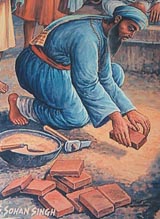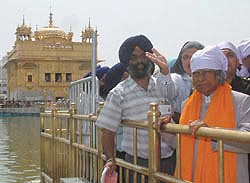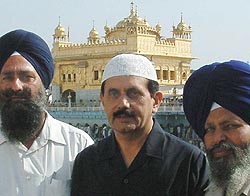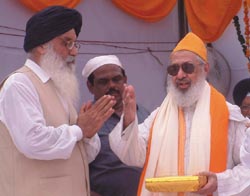drkhalsa
SPNer
- Sep 16, 2004
- 1,308
- 54
History revisited
Some historians claim Guru Arjan Dev laid the foundation stone of Harmandar Sahib, while others give the credit to Muslim saint Sain Mian Mir. In this confusion, however, the lessons of universal brotherhood and communal harmony that shine through the Sikh history are increasingly getting lost, writes Varinder Walia
A painting shows Sain Mian Mir laying the foundation stone of Harmandar Sahib.
The limited authentic historical record coupled with conflicting reports about the events regarding the laying of the foundation stone of Harmandar Sahib has baffled many historians and common people.
Confusion also abounds about the visit of great Punjabi Sufi poet Bulleh Shah to the Holy City.
The confusion about the foundation stone was compounded by the self-contradictory information given in the SGPC’s literature and its website.
The Shiromani Committee since 80 years of its inception has not been able to provide complete and authentic information about the unflinching devotion of Muslims towards Harmandar Sahib. Consequently, Sikhs have more information about the Mughal attacks than about the devotion shown by the Muslims towards “Guru Ghar”.

President A.P.J. Abdul Kalam pays obeisance at Harmandar Sahib. Photos: Rajiv Sharma

Rai Aziz Ullah Khan, Member, National Assembly, Pakistan, visited Harmandar Sahib to participate in kar seva.

Nawab Habeeb Jang Bahadur from Hyderabad is the direct descendant of Baba Farid. Photos
by Rajiv Sharma
Dr Harminder Singh Bedi, Dean, Guru Nanak Dev University, and Head, Hindi Department, says that the devotional aspect of Muslims towards Sikhs needs more research to remove historical misrepresentations.
Even as various historians have stated that the foundation stone of Harmandar Sahib was laid by Muslim seer, Sain Mian Mir, the fact was vehemently denied by the former Jathedar Akal Takht, late Giani Kirpal Singh, in his well acclaimed book, “Sri Harmandar Sahib da Sunehri Itihas” (Golden History of Harmandar Sahib), published by the SGPC’s Dharma Parchar Committee.
Another Sikh scholar, Dr Madanjit Kaur, in her book “The Golden Temple: Past and Present” also concluded that the foundation stone was laid by the Sikh Guru and not by Sain Mian Mir. However, the confusion about this significant historical event was further deepened by the SGPC’s websites having two versions in this regard. The initial website reads that the foundation stone was laid by Sain Mian Mir, while its revised version says it was laid by the Guru himself.
The SGPC’s first website says: “Guru Arjan Dev got the foundation of Harmander Sahib laid by a Muslim saint Hazrat Mian Mir ji of Lahore on 1st of Magh, 1645 Bikrmi Samvat (December, 1588). The construction work was directly supervised by Guru Arjan Sahib himself and he was assisted by the prominent Sikh personalities like Baba Budha ji, Bhai Gurdas ji, Bhai Sahlo ji and many other devoted Sikhs.”
However, the amended website of the SGPC reads, “The foundation of the Darbar Sahib had been laid by Guru Arjan Sahib on January 3, 1588. (Later, it was propagated that the foundation stone of Darbar Sahib was laid by Sain Mian Mir, a Muslim holy man. Sain Mian Mir was very friendly with Guru Sahib but the foundation of Darbar Sahib was laid by Guru Sahib himself).”
J.R. Puri and T.R. Shangari, Indian historians , write: “It is well known that Guru Ram Das got the foundation of Harmandir Sahib in Amritsar laid by Mian Mir.”
However, Lahore-based Makhdom Syed Chan Pir Qadri, the 19th descendant of Sain Mian Mir, during his recent visit to Amritsar had claimed that there was enough historical evidence that the foundation stone of Harmandar Sahib was laid by Sain Mian Mir. This had ushered in the era of Muslim-Sikh friendship at that time. He made this claim on the historical fact that Guru Nanak Dev himself had spread a message of peace and spiritual unity in India.
Another Muslim link with Harmandar Sahib, which has been ignored by historians, is whether Bhai Mardana visited the Sikh shrine. Bhai Mardana, a Rababi expert, was Guru Nanak’s long-time Muslim companion throughout his extensive journeys. Though three “shalokas” (hymns) composed by Bhai Mardana have been incorporated in Guru Granth Sahib, yet there is no authentic record of his visit to Harmandar Sahib.
Giani Kirpal Singh (a former Jathedar, Akal Takht), while quoting from the historical facts given in “Twarikh Guru Khalsa”, authored by Bhai Gian Singh claimed that Guru Nanak Dev and Bhai Mardana had visited the site (which later became Harmandar Sahib) many times. They used to sing hymns there. He said this fact got credence as the site of Harmandar Sahib was on the Kartarpur-Sultanpur-Lodhi road. Guru Nanak Dev used to go to Sultanpur Lodhi, where his elder sister, Bebe Nanki, was married. However, Mr Roop Singh, a prolific writer and Assistant Secretary, SGPC, said he could say with surety that the visit of Guru Nanak Dev and Bhai Mardana to the site of Harmandar Sahib was a “concocted story”. The holy verses composed by Bhai Mardana are included in the Adi Granth in “Bihagre ki Var”. These verses are against the use of wine that brings about “misery, lust, pride, self-conceit, falsehood, ill health and disease”.
Another historical fact given by Giani Jang Singh in his “Amritsar Sifti Da Ghar” (Amritsar: The City of Values), published by the Sikh Itihas Research Board (SGPC) in 1977, claimed that Bulleh Shah (1680-1758) had once visited Harmandar Sahib. Quoting one of his “Qafis”, the author claimed that Bulleh Shah had praised the serving of “langar” (community kitchen) and performance of kirtan in the Sikh shrine. However, no wall of the Sikh Museum of Harmandar Sahib adorns the picture of Bulleh Shah nor is any other historical reference available to authenticate the version of Giani Jang Singh.
Bulleh Shah was one of the greatest Sufi poets of Punjab and was so unorthodox in his life that he was refused burial in the community graveyard by the Muslim priest after his death.
Baba Farid (1173 -1266) is another Sufi poet who is considered as the “first poet” of Punjabi language. Nawab Habeeb Jang Bahadur of Hyderabad, direct descendant of Baba Farid, visited Harmandar Sahib during the quadri-centennial celebrations of the installation of Guru Granth Sahib. He was honoured with a “siropa” (robe of honour) by the Shiromani Akali Dal supremo, Mr Parkash Singh Badal. Baba Farid was a mystic and belonged to the radical Sufi Chishti School. He built his poetry on simple expressions based on folk traditions. The Muslim Rababis used to perform kirtan in Harmandar Sahib till the formation of the SGPC in 1925. Ghulam Mohammad Chaand ( from the family of Bhai Mardana) during his recent visit to Amritsar was disheartened to know that he could not perform kirtan in the sanctum sanctorum of Harmandar Sahib like his forefathers did. His paternal uncle, Bhai Chaand, was the “Hazoori Raagi” of the Golden Temple before Partition.
Frontier Gandhi’s visit While Dr A.P.J. Abdul Kalam, President of India, visited Harmandar Sahib on the quadri-centennial (400th) celebrations of Guru Granth Sahib, Khan Abdul Gaffar Khan, popularly known as “Frontier Gandhi”, paid obeisance at the Sikh shrine in 1969 to mark the 500th birth anniversary of Guru Nanak Dev. He was bestowed with a “siropa” (robe of honour) by Sant Fateh Singh.
Pak writer’s view A Pakistan-based Punjabi writer, Iqbal Qaiser, in his “Historical Sikh Shrines in Pakistan” writes: “Sain Mian Mir Ji was born at Sevastan (Sindh) in 1531 AD. Guru Arjun Dev got the foundation stone of Harmandir Sahib laid by Mian Mir on 1st Magh, Samvat 1647 (3rd January 1588 AD). Mian Mir raised slogans to mourn the martyrdom of Guru Arjun Dev. At the command of Maharaja Ranjit Singh the tomb was repaired, renovated and Rs 500 was granted from the royal exchequer. Maharaja used to come to the fair every year and made large contributions”.
Pir Syed Mohammad Ryan Chisti, Gaddi Nassin Ajmer Sharif: “Visit to this gurdwara gave a feeling that it is an abode of God.”
Dr M.Rahman, Administrator, Punjab Wakf Board: “A unique experience of its own kind. It is a place of total edification and unparallelled upliftment.”
A.A. Siddiqui, former DGP, Punjab: “It is amazing to see peace and tranquility in such a sea of humanity where everyone is busy in talking to God through his greatest prophet of peace, Guru Nanak. God bless all of us through the divine blessings of the Guru. Amen.” Aitzaz Hasan, Member, National Assembly, Pakistan: “This is a sacred soil — sacred to all humanity — to all peoples, nations and religions. This is a place where light that lit up the path to all religions — Muslims, Hindus and Christians — originated.”
Earliest tradition
The renowned Sikh historian and author of “The Golden Temple: Past and Present”, writes: “According to the earliest Sikh tradition, the foundation stone of the Harmander was laid by Guru Arjan himself. A mason, so goes the story, accidentally displaced the brick (the foundation stone). On seeing this, the Guru prophesized that the foundation would be laid again in the near future. This version of Bhai Santokh Singh is carried by almost all subsequent Sikh sources right up to the twentieth century ….”
The author further writes: “The story of Mian Mir having laid foundation of Harmander appears amongst the Persian sources for the first time in Bute Shah’s, ‘Tawarikh-I-Punjab’… The real objective of the author (Bute Shah) was to eradicate any chance of animosity between Sikhs and Muslims after fall of Sikh Kingdom…” “The first recorded reference to this version in European sources is to be met immediately in, “The Punjab notes and queries”. It records: ‘The foundation stone was laid by Mian Mir...’ The contributor of the entry, E. Nicholl, (Secretary, Municipal Committee, Amritsar) does not cite any authority, he merely states the facts”.




